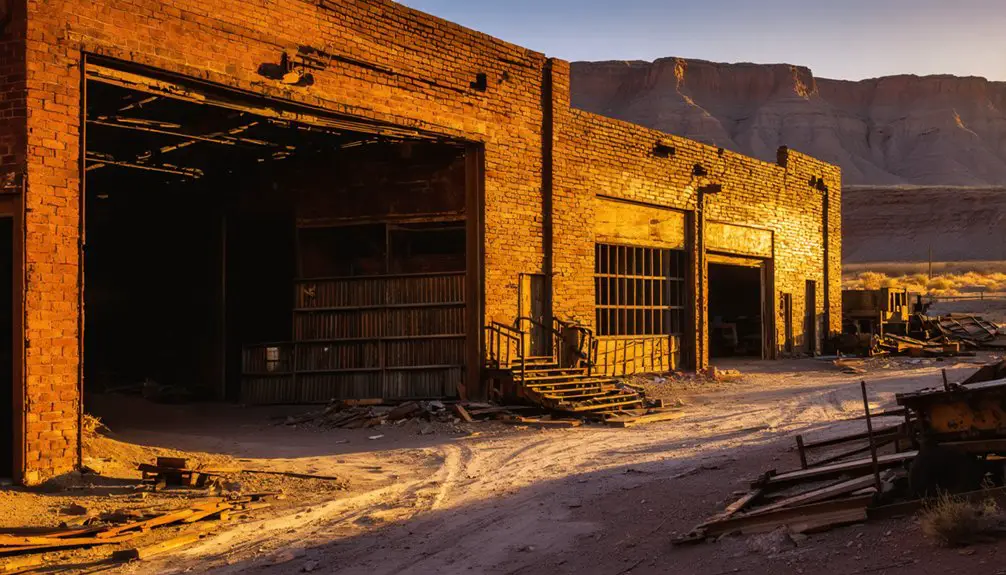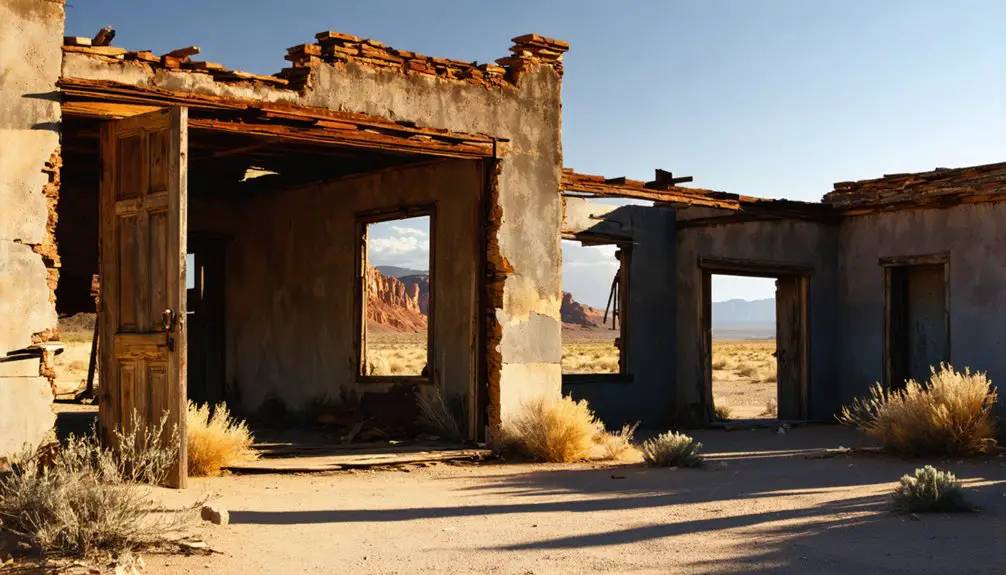You’ll discover Dragon’s ruins in Utah’s remote Uinta Basin, where this mining boomtown thrived from 1888 to 1938. Named after the Black Dragon mine, it grew to 487 residents following rich Gilsonite discoveries. The arrival of the Uintah Railway in 1904 transformed Dragon into a major transportation hub, but fires and the railway’s northward relocation led to its abandonment. The ghost town‘s crumbling structures and cemetery hold fascinating tales of Utah’s industrial frontier.
Key Takeaways
- Dragon, Utah was established in 1888 as a mining town after discovering rich Gilsonite deposits in the Uinta Basin.
- The town reached its peak population of 487 residents in the early 1900s, thriving on Gilsonite mining and railway transportation.
- Dragon served as a major railway terminus for the Uintah Railway, facilitating mineral transportation and connecting isolated mountain communities.
- The community featured essential structures including a post office, hotels, boarding house, library, and school during its productive years.
- Dragon was abandoned by 1940 following railway closure, mine shutdowns, and devastating fires, leaving only ruins and a cemetery.
The Birth of a Mining Frontier Town
When prospectors discovered rich Gilsonite veins in Utah’s remote Uinta Basin, the frontier town of Dragon emerged in 1888 at the mouth of Dragon Canyon along Evacuation Creek. Named after the Black Dragon mine, where veins of this unique hydrocarbon mineral mimicked a dragon’s shape, the settlement quickly established itself as a hub for mining operations. Like the ancient civilizations who discovered great serpents in their fossil remains, the miners saw dragon-like forms in the mineral deposits they unearthed.
You’ll find Dragon’s mining heritage reflected in its rapid development from a simple camp into a bustling frontier community of 487 residents. The town’s community dynamics centered around the extraction of Gilsonite, with veins stretching 3 to 6 feet wide and plunging 2,000 feet deep. In 1904, the arrival of the Uintah Railway transformed Dragon into a major transportation hub.
Despite its isolation in the arid basin near the Utah-Colorado border, Dragon soon boasted essential facilities including a warehouse, boarding house, school, and two saloons.
Gilsonite: The Black Gold of Dragon Canyon
You’ll find that Dragon’s earliest miners extracted Gilsonite using basic tools like picks and shovels, relying on horse-powered hoists before mechanization revolutionized the process.
This rare hydrocarbon, discovered near Dragon Canyon in 1888, quickly became prized for its versatility in everything from road construction to printing inks and oil well drilling fluids. The region’s unique deposits in the Uinta Basin made Utah home to the world’s largest reserves of this valuable asphaltite.
The Black Dragon Mine‘s output helped transform Dragon into a bustling hub of commerce, complete with rail connections that shipped this valuable resource to markets across America. The town’s growth led to the establishment of two local saloons, providing entertainment for the hard-working mining community.
Mining Methods and Tools
The extraction of gilsonite from Dragon Canyon‘s deep vertical veins demanded specialized mining techniques due to the ore’s unique properties and explosion risks.
You’d find miners sinking shafts along the veins and extending lateral drifts to access the precious black mineral. For extraction safety, they’d leave the top 30 feet unmined and rely primarily on air-powered chipping hammers to avoid wall rock contamination.
The ore handling system you’d see underground was ingenious – broken gilsonite would travel down steep slopes into vacuum tubes, then be pneumatically lifted to surface bag houses. Early miners transported the ore using mule teams before modern trucking methods were implemented.
While early miners used simple hand tools and cloth bags, they’ve since tested various equipment including water-jet cutters and continuous mining machines with rotary heads, always adapting to manage the material’s explosive nature.
The mining operations in Dragon Canyon were part of a larger deposit spanning an area of 60 by 30 miles across Utah’s Uinta Basin.
Economic Impact and Uses
Since its discovery in the late 19th century by Samuel Gilson, gilsonite transformed Utah’s Uinta Basin into a thriving industrial hub, reaching production values of $89 million by 2012 at $1,085 per short ton.
You’ll find evidence of this economic growth in the region’s infrastructure, including purpose-built railways that transported this valuable mineral from boom towns like Dragon, Watson, and Rainbow.
Today, gilsonite’s industrial applications span hundreds of uses, from oil well drilling to asphalt paving and specialty coatings.
The oil and gas sector‘s demand has skyrocketed, with sales increasing over 150% since 2009.
While early mining towns became ghost towns as nearby veins depleted, Bonanza remains active, and millions of tons still lie in deeper veins.
Major producers have invested $20 million to double production, ensuring gilsonite’s continued economic significance.
Before establishing proper housing, mining families like the Neals lived in large tents while working the gilsonite deposits.
Life Along the Uintah Railway
You’d have found life along the Uintah Railway defined by extreme challenges, as workers battled 7.5% grades, 66-degree curves, and snow that could pile up to passenger car windows at Baxter Pass’s 8,473-foot elevation.
The railway transported Gilsonite in sacks on open flat cars. The railway’s maintenance hub at Atchee served as home base for crews who maintained the line’s 73 bridges across 28 miles of rugged terrain, while specialized locomotives like the custom-built articulateds #50 and #51 tackled the demanding route. Passenger train service operated for sixteen years until 1921.
Communities like Dragon, Mack, Wendella, and Watson grew around the tracks, supporting both the railway operations and the Gilsonite mines that provided the line’s primary revenue.
Railway Construction Challenges
Building railway infrastructure through Utah’s rugged Uintah Basin presented formidable engineering challenges that required extensive planning and resource allocation.
You’ll find the construction difficulties were particularly intimidating, with crews having to move massive amounts of earth across steep mountain terrain and establish rail beds in previously roadless areas. The project crossed over 400 streams, demanding precise engineering to protect water flow patterns.
Environmental considerations shaped every aspect of construction. Workers had to carefully navigate through 12 miles of national forest while protecting critical wildlife habitats. The Surface Transportation Board’s permit faced significant legal scrutiny due to environmental compliance concerns.
The clearing of roughly 10,000 acres impacted various species, including pronghorn and sage grouse. You can imagine the complexity of coordinating with multiple agencies, from the U.S. Forest Service to tribal authorities, while maintaining strict environmental compliance throughout the challenging mountain landscape.
Daily Train Operations
When the Uintah Railway began daily operations in 1905, a single 0-6-2 tank locomotive pulling a passenger combine car traversed the challenging 65-mile narrow gauge line between Mack, Colorado, and the mining towns of Dragon and Watson.
You’d find train maintenance crews stationed at Atchee’s repair shops, keeping the specialized locomotives in working order for their demanding runs.
As operations expanded, the railway upgraded its locomotive technology, adding powerful Shay engines and unique articulated locomotives #50 and #51 to tackle the extreme 7.5% grades and 66-degree curves.
These were America’s only narrow gauge compound articulateds, masterfully handling the route’s 2,000-foot climbs and 1,500-foot descents.
Daily schedules balanced freight services – primarily 150-200 pound sacks of Gilsonite – with passenger runs that connected isolated communities through harsh mountain conditions.
Community Around The Tracks
Life along the Uintah Railway revolved around a string of interconnected communities that sprouted up to serve both the mining operations and rail services.
Towns like Dragon, Rainbow, and Atchee buzzed with railway workers maintaining tracks and equipment, while miners extracted valuable Gilsonite nearby. Community cohesion emerged through shared workspaces and daily routines, as residents relied on the railway for everything from mail to groceries.
- You’d find maintenance crews clustered in Atchee, where the main railway shops kept operations running smoothly.
- Miners lived alongside railway workers in camps and settlements, creating tight-knit communities bound by their rugged lifestyle.
- The railway served as your lifeline through challenging terrain, delivering essential supplies and connecting you to neighboring towns until roads took over.
Daily Life in Dragon’s Golden Era

During Dragon’s peak years in the early 1900s, nearly 500 residents carved out their existence in this remote Utah mining settlement, where Gilsonite extraction and the Uintah Railway dominated daily routines.
You’d find yourself among a tight-knit community of miners, railroad workers, and merchants, gathering at one of the town’s two saloons for cultural gatherings after long workdays.
The library, established in 1910, offered free books transported by rail, while the local school educated the miners’ children. Community events often centered around the boarding house, where travelers and workers exchanged news and stories.
Despite the harsh desert environment and ever-present fire risks from flammable Gilsonite, you’d experience a rugged freedom typical of western mining towns, complete with essential services like the barber shop and telegraph connection to Fort Duchesne.
The Architecture and Infrastructure
Buildings in Dragon embodied the stark practicality of early 1900s mining settlements, with wooden frames and stone foundations dominating the townscape at the mouth of Dragon Canyon.
Simple wooden structures on stone bases defined Dragon’s landscape, capturing the raw utility of frontier mining towns.
You’ll find the town’s spatial organization clustered tightly around the Uintah Railway terminus, where building techniques adapted to both the harsh environment and limited resources. Fabric coverings on exterior walls served as innovative wind barriers, while simple, functional layouts reflected the town’s mining-focused purpose.
- Town infrastructure included essential services like the post office, hotels, and blacksmith shop, all positioned along the main street that paralleled the railway.
- Basic dirt roads connected residential areas to commercial zones and nearby Gilsonite mines.
- Building materials were primarily local wood and stone, with minimal masonry due to transportation constraints.
Mining Operations and Economic Impact

After Gilsonite’s discovery in Dragon Canyon in 1888, mining operations quickly transformed the area into a bustling industrial hub.
You’ll find the historical significance of Dragon’s economy centered on the extraction of Gilsonite from vertical fissures using picks and shovels, with miners filling 200-pound burlap bags.
The completion of the Uintah Railway in 1904 revolutionized the region’s mining potential, connecting Dragon to the Denver and Rio Grande Western line.
Despite labor challenges like the physically demanding work and depth limitations of about 100 feet, the industry thrived.
The town expanded with essential facilities including a depot, warehouses, shops, and boarding houses.
Dragon’s position as a terminal town at the railway’s end made it a vital distribution point for Gilsonite, which had hundreds of industrial applications nationwide.
The Decline and Abandonment
Dragon’s prosperity began to unravel in 1911 when the railroad terminus moved farther north, shifting economic activity to the town of Watson.
You’ll find that a series of devastating fires, including a two-year-long Gilsonite vein fire in 1908, had already weakened the town’s economic foundation.
By 1938, mining operations ceased entirely, and the Uintah Railway’s closure in 1939 sealed Dragon’s fate.
The final nails in Dragon’s coffin came swiftly – mines shuttered in 1938, followed by the railway’s demise a year later.
- Population plummeted from a thriving community to just 72 residents in 1939, then crashed to 10 by 1940
- Schools, saloons, and stores shuttered as social decline accelerated
- Harsh desert isolation and depleted Gilsonite deposits prevented economic alternatives
The ghost town’s final chapter closed as remaining residents departed, leaving only ruins and a cemetery in the barren Uinta Basin – a stark reminder of Dragon’s brief but vibrant mining era.
Exploring Dragon’s Ruins Today

Today, you’ll find Dragon’s haunting remains in eastern Utah’s Uintah County, just a mile west of the Colorado border. At 5,771 feet elevation, this ghost town exploration offers scattered ruins of buildings, foundations, and concrete structures from its mining heyday, including remnants of the old blacksmith shop and railroad depot.
You can access Dragon via the Rector/Dragon Trail, a popular OHV route that combines scenic adventure with historical discovery.
While exploring the rough desert terrain, you’ll encounter old railroad ties, mining equipment, and artifacts like glass shards and plates that tell the story of daily life. The site remains remote, so you’ll need to come prepared – there are no modern facilities.
Nearby attractions include Red Fleet State Park and Dinosaur National Monument for extended exploration opportunities.
Preserving Dragon’s Historical Legacy
While visitors can explore Dragon’s physical remains, preserving this unique piece of Utah’s mining heritage presents significant challenges.
The ghost town’s remote location in the Uinta Basin makes preservation strategies difficult to implement, yet community engagement efforts continue through local historical societies and ghost town enthusiasts.
You’ll find that unlike other restored Utah ghost towns such as Grafton, Dragon lacks formal restoration projects, though its significance as a Gilsonite mining center from 1888 to 1940 makes it historically valuable.
- Virtual tours and 3D modeling can help document the site’s current condition
- Installation of interpretive signage would educate visitors about Dragon’s mining legacy
- Stabilization of existing ruins and cemetery requires immediate attention to prevent further decay
Frequently Asked Questions
Are There Any Reported Ghost Sightings or Paranormal Activity in Dragon?
You won’t find documented ghostly encounters or haunting tales in Dragon’s ruins. Historical records, paranormal databases, and local sources don’t mention any supernatural activity at this former Gilsonite mining settlement.
What Happened to the Residents After Dragon Was Abandoned?
You’ll find Dragon’s residents primarily relocated to nearby mining towns like Bonanza or larger communities like Vernal, Utah. The residents’ fate aligned with typical patterns of dispersal from depleted mining communities.
Was Dragon Ever Affected by Major Natural Disasters?
You won’t find records of major natural disasters in Dragon. Beyond mining-related fires, there’s no evidence of earthquake impacts or flood history in this high-elevation Uinta Basin settlement.
Did Any Famous People or Historical Figures Visit Dragon?
You won’t find records of any famous visitors to Dragon in historical documents. The town’s historical significance centered on Gilsonite mining and the Uintah Railway rather than notable personalities.
Were There Any Significant Crimes or Lawless Incidents in Dragon?
You won’t find significant crime history in Dragon’s records. Unlike other Utah mining towns, it lacked major lawless incidents, with mining hazards and fires posing greater threats than law enforcement challenges.
References
- https://en.wikipedia.org/wiki/Dragon
- http://www.expeditionutah.com/forum/index.php?threads/ghost-town-dragon.5317/
- https://salida.marmot.org/Archive/place:1629/Place
- https://www.youtube.com/watch?v=44hBQkrORuU
- https://www.utah.com/listing/rector-dragon-trail/17345/
- https://www.houseofhighways.com/campgrounds/usa/west/utah/dragon
- https://gilsoniteco.com/gilsonite-utah-mine/
- https://geology.utah.gov/map-pub/survey-notes/utah-still-supplying-gilsonite-to-the-world-after-125-years/
- https://www.onlineutah.com/dragonhistory.shtml
- https://geology.utah.gov/map-pub/survey-notes/gilsonite-an-unusual-utah-resource/



